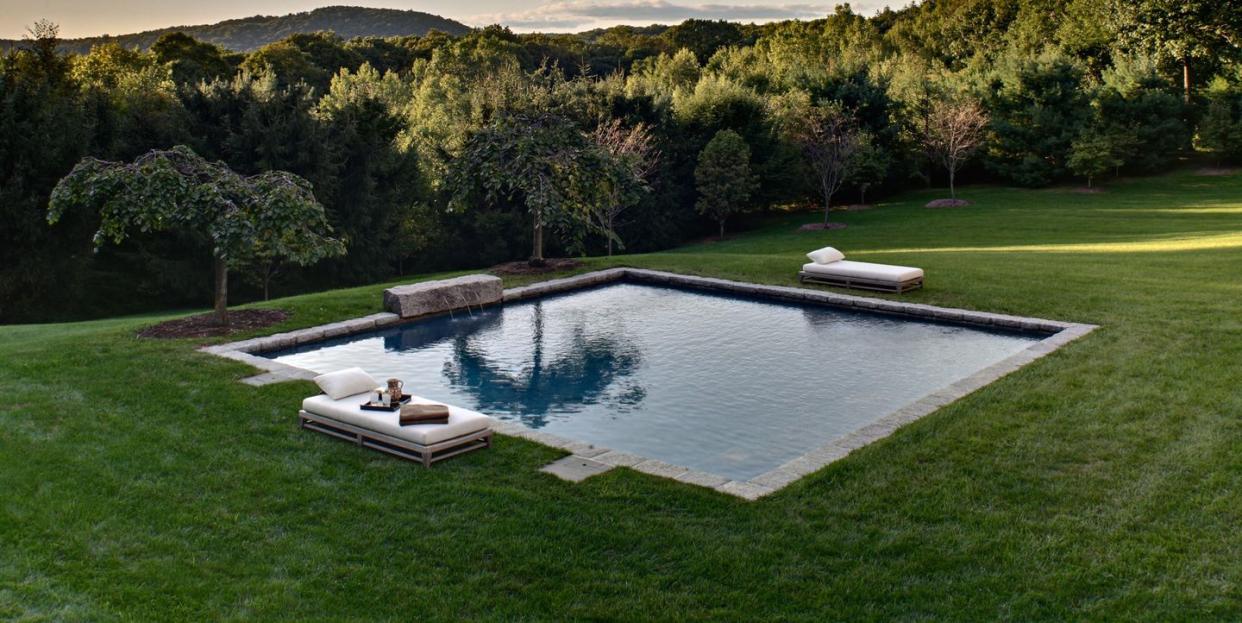ICYMI, Self-Cleaning Pools That Don't Use Chlorine or Salt Exist

There's nothing quite like the feeling of diving into cool, refreshing water on a hot summer day, so it should come as no surprise that tons of Americans are interested in installing pools in their yards. But as more Americans become more health and environmentally conscious, there's been increased interest in alternatives to the typical chlorine swimming pool. Just what does that entail? We asked experts for the scoop on natural pools and other alternatives, like salt pools. Read on for answers to all your burning questions.
What is a natural swimming pool?
A natural swimming pool is an inset body of water that functions without the use of chemicals. True natural pools clean themselves via a self-cleaning ecosystem within or adjacent to the pool. The first examples of natural swimming pools, which were inspired by natural swimming holes and ponds, were made in Germany. The phenomenon of chemical-free pools remains popular throughout Europe.
How does it work?
A natural pool will either comprise or be adjacent to a planted area that acts as its filter and will include some type of circulation. Some companies, like Kansas-based Total Habitat, offer models where the swimming area "is separated from the planted, built-in biological filter area with an underwater retaining wall." These include more conventional pool aspects, like jets, a skimmer, and an entry ladder. Simpler versions of a natural pool might be less separated from their natural filters, but will still need circulation.
Is it right for me?
Maybe. More extreme temperatures (in both directions) make natural swimming pools a little trickier to maintain in the U.S. than in Europe. Julie Dobson of Dobson Pools, a second-generation family-owned pool installer in Connecticut (who installed the pool above), warns that a natural pool may not be right for all environments. "They are really impractical for our region because our swim season is only 3 months," she explains. "The body of water is sitting stagnant for the rest of [the year]." Dobson notes that the few clients for whom she has installed natural pools have wound up converting to another system. In hotter climates, natural pools will need a top-tier filtration system to control algae.
What are my other options?
According to Dobson, a popular alternative, especially in the northeast, is saltwater pools, which comprise 95 percent of Dobson Pools's new builds. While these pools aren't chlorine-less, they are much better for the environment. "Salt pools have what are called salt-chlorine generators," explains Dobson. "These convert basic table salt into chlorine with electrolysis, so the salt is electronically charged." That way, she explains, "factories don’t have to be producing chlorine." Plus, the chlorine generated by electrolysis is "so much softer on the skin."
What should I know when installing?
There are several factors to consider when installing any type of pool, but especially natural ones. "One important thing to think about is the orientation of the sun," says Rod Pleasants, designer and President of McIver Morgan, who has done dozens of pool installs over his career (including the saltwater version shown above). Since natural pools don't have heaters, "you want to have a pool that’s in the sun almost all day, if possible," Pleasants explains. "During the summer, if it’s oriented properly, it will be reasonably warm without a heater."
That may pose complications for arranging poolside furniture: "Most of my clients want areas out of the sun," Pleasants says, noting the greater awareness of skin cancer among clients, especially parents. But if you can find a place where "that shade is close enough to the pool, where the parent can watch them," it might work for you.
How much can I expect to spend?
There's a wide range. If you're just looking to lay down a vinyl or fiberglass liner, prices might start at $5,000 or $10,000 (though it's worth noting vinyl ones will need to be replaced every few years). If you want a custom build and install, you're looking more in the $70,000 range, estimates Total Habitat (for comparison, non-natural pools will usually run from $37,000 for vinyl to $60,000 for concrete, according to Fixr). A salt-conversion system for an existing pool, Dobson says, costs around $3,400.
Can I do it myself?
You probably shouldn't. Though there are YouTube tutorials for DIY natural pools of the simpler variety (with little more than a rubber liner), your best bet is to hire a professional to ensure the safety and longevity of your pool. Companies like Total Habitat specialize in natural pools; you can also consult a local pool installer, like Dobson.
What's the maintenance like?
Like their chlorinated counterparts, natural pools usually have filters that will need to be cleaned regularly. Unlike chlorinated pools, though, there's no need to add chlorine (obviously), and you won't have to vacuum since the natural elements in the pool are supposed to be there. That said, there are some additional maintenance aspects that come with owning a natural pool. The biggest is the install, when you'll have to ensure the filtration ecosystem is correctly planted to adequately filter the water. In addition, Total Habitat recommends adding "beneficial bacteria" to the water at the start of each season to jump-start the biological filter.
Will it increase my home's value?
It might, though probably not a ton. The data set for natural pools specifically is too low to analyze, but Zillow says that homes with pools, in general, sell for 1 percent higher than those without and are snapped up a few days faster, according to MarketWatch. That said, homes with poorly maintained pools are likely to have a harder time selling.
Have questions about your next renovation project? We’ve got answers. Let’s do this together.
Follow House Beautiful on Instagram.
You Might Also Like

